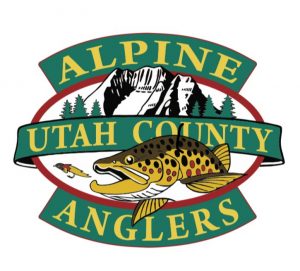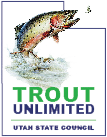Alpine Anglers of Utah County
TU Chapter 932
 Alpine Anglers serves Utah and the surrounding area. We have been involved in numerous conservation projects associated with the Provo River and its drainage, Strawberry Reservoir and its tributaries, and those waters flowing from the mountains east of Utah Valley. We currently hold our meetings at the famed Sundance Resort. Currently, we have over 150 active TU members in our Chapter.
Alpine Anglers serves Utah and the surrounding area. We have been involved in numerous conservation projects associated with the Provo River and its drainage, Strawberry Reservoir and its tributaries, and those waters flowing from the mountains east of Utah Valley. We currently hold our meetings at the famed Sundance Resort. Currently, we have over 150 active TU members in our Chapter.
American Fork River
On August 20, 2016, an angler casting for trout on Utah’s popular American Fork River noticed something was terribly wrong: a thick, toxic sludge was flowing down the river, killing the trout. Hours before and seven miles upstream, a dam-repair contractor made a fatal mistake. Fatal for the trout. The angler immediately reported the unfolding disaster to the leaders of his Chapter of Trout Unlimited, Utah County Alpine Anglers, who started making phone calls. Despite river-protection procedures approved during permitting, the North Utah County Water Conservancy District (NUCWCD) and its contractor Whitaker Construction disregarded environmental-protection requirements and discharged a century-and-a half of mining-waste sediment from the reservoir as they drained it for repairs. NUCWCD has since been fined to reimburse Utah’s Division of Water Quality for its frenetic water-quality testing and sediment sampling. Additionally, a legal settlement included punitive damages to fund restoration projects. Part of the punishment was justified by NUCWCD’s failure to report the “spill” until days after the angling public started noticing the 5,200 dead fish. After the disaster, I bided my time before finally visiting the river to assess its cleaned-up-and-partially-restored condition in November 2017. I found no obvious signs of the disaster, and the river appeared to have recovered. I was pleasantly surprised to catch many rainbow trout below Tibble Fork Dam. These were all 11-inch cookie-cutter rainbows that had been stocked in the summer of 2017 after most of the toxins had dissipated. However, stocking the American Fork with 9-to- 10-inch rainbows is not a new approach in the seven-mile stretch below Tibble Fork Reservoir. The number and size of stocked trout were nearly the same in 2017 as it was every year prior to the toxic spill. American Fork below the dam has always been a put-and take fishery that the DWR has historically stocked annually with six-thousand trout during July and August.
 Wild trout in the river take a back seat to the stocked rainbows, but when I waded the river, I spooked spawning brown trout from their redds, and I talked to a fellow angler who had caught a brook trout. Wild fish are moving back into the damaged section from small tributaries and from lower in the river system. American Fork River above Tibble Fork Reservoir was not impacted by the dam reconstruction or the resulting toxin release, and I found it loaded with wild brown trout for its entire length. Although it too has ecological challenges, the fishery there is in good condition. The original sources of the mining sediments that were released during the dam work are the many abandoned mines in American Fork’s headwaters. Long abandoned mine shafts have filled with groundwater and seep water laden with heavy metals, which tint the reservoir a beautiful turquoise. Eleven years ago, Trout Unlimited (TU) collaborated to clean up old mine tailings to improve water quality. Tailings were moved away from the river and were encapsulated in huge berms of soil to sequester the heavy metals.
Wild trout in the river take a back seat to the stocked rainbows, but when I waded the river, I spooked spawning brown trout from their redds, and I talked to a fellow angler who had caught a brook trout. Wild fish are moving back into the damaged section from small tributaries and from lower in the river system. American Fork River above Tibble Fork Reservoir was not impacted by the dam reconstruction or the resulting toxin release, and I found it loaded with wild brown trout for its entire length. Although it too has ecological challenges, the fishery there is in good condition. The original sources of the mining sediments that were released during the dam work are the many abandoned mines in American Fork’s headwaters. Long abandoned mine shafts have filled with groundwater and seep water laden with heavy metals, which tint the reservoir a beautiful turquoise. Eleven years ago, Trout Unlimited (TU) collaborated to clean up old mine tailings to improve water quality. Tailings were moved away from the river and were encapsulated in huge berms of soil to sequester the heavy metals.
Currently, Snowbird Ski Resort is planning to expand its ski operations in the drainage and has resumed talks with TU, the conservation organization Preserve and Protect American Fork Canyon, and other organizations about cleaning up mine tailings. But conservation organizations are reticent to disturb abandoned mine tailings without passage of “good Samaritan” legislation (to deflect liability) that has languished in congress for a decade. The upper sections of the American Fork River are accessible from a bumpy dirt road that follows the river up
the canyon. In one steep section of the river, the Jeep road switchbacks away from the river for a mile or so, then rejoins the river and crosses it at Dutchman Flat. Between the switchbacks and Dutchman Flat, the road is far uphill from the river and the canyon wall is too steep to descend, necessitating that anglers enter the river below the switchbacks to hike and wade upriver in order to access this least-fished section. While scouting for trout in Dutchman Flat, I watched two brown trout jump up an 18-inch waterfall and hold among the rocks in the shallow water above. I drifted a copper john among the cobbles, and I watched in anticipation as one of the trout darted from behind a rock to snatch it. Brown trout dominate the wild-trout water above the reservoir; however, catching a brook trout in any section is possible, although not probable. Springs dot the river bank, and the river structure abounds with deep runs and pockets. The deepest holes in the river are plunge pools below log jams, and the largest trout seem to hang out in their depths. Fly patterns are not as important as good presentations with “confidence” flies. Getting good drifts with a brace of nymphs is difficult in plunge pools, but persistence and experimentation pay off with hookups. By my assessment, the American Fork River above Tibble Fork Reservoir fishes as good as ever, and the few miles below the dam seem to have recovered quickly. Fishing is again excellent on all stretches of the American Fork River. A fee of $6 is charged to enter the canyon, which is part of the Uinta National Forest.

